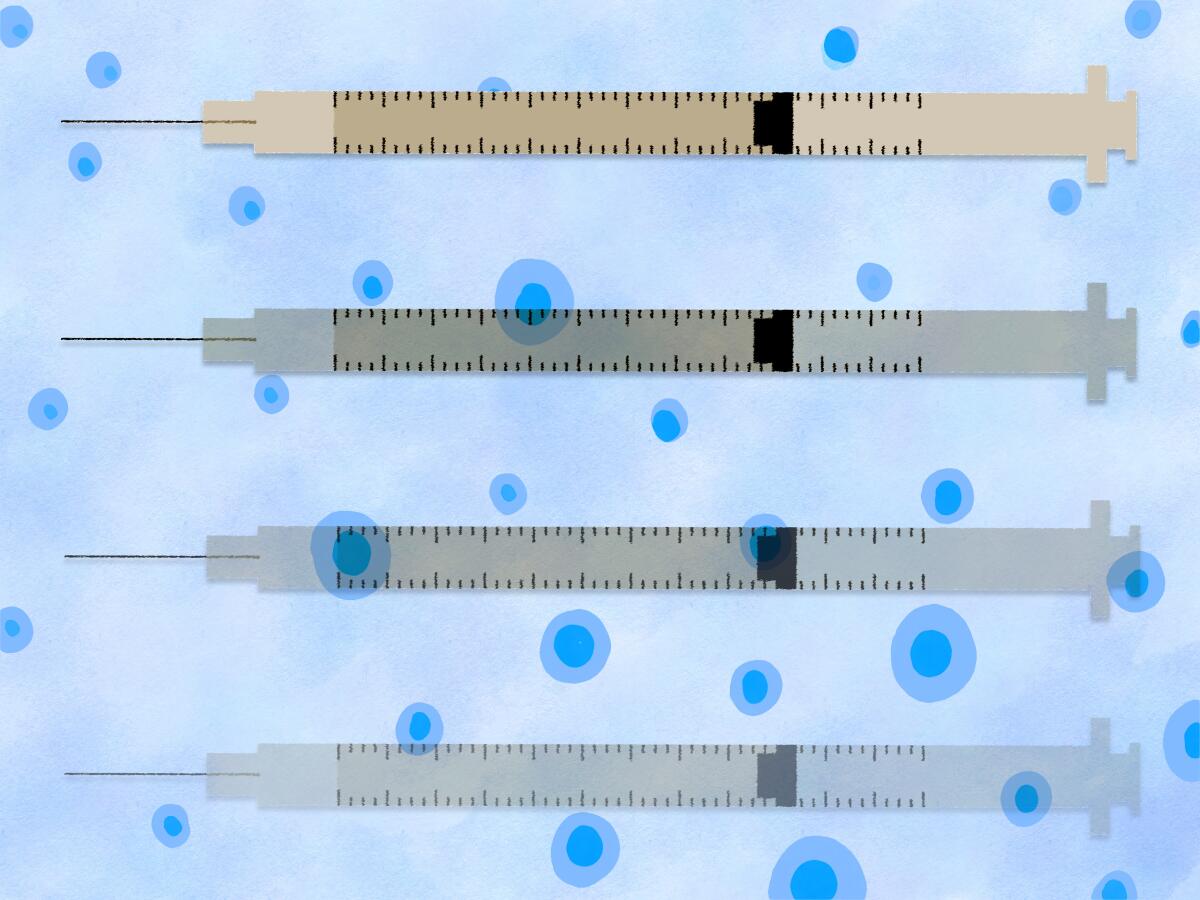Op-Ed: Can the COVID-19 vaccines keep us safe from virus variants over the long term?

- Share via
Imagine that it is 2023 or 2025, and protection from our COVID-19 vaccines is starting to wane or mutant virus strains are evading the vaccines. Can we realistically expect the entire populace to line up again in stadiums and parking lots to get a shot?
The rapid development of effective vaccines has been worthy of celebration. But we’re now facing a major practical question: How long will the vaccines work and can the immunity provided so far defend against new viral variants? The answer will depend on the quality of immune memory that the vaccines can produce.
Immune memory, our “remembrance of germs past,” is how we are protected after vaccines or natural infection. Humans develop immune memory in two primary ways: through antibodies and T-cells. Either can play the key role in protection, depending on the infectious agent, and their relative importance is still debated by immunologists. Antibodies in the bloodstream are a first line of defense against viruses and are easy to measure, so these have typically been the focus of vaccine development. But memory T-cells provide our most multifaceted and durable protection against intracellular infections like viruses.
Once a virus gets into our cells, it’s too late for antibodies to help. T-cells are then required to destroy the virus-infected cells and prevent serious disease or spread of the virus. Memory T-cells remember an encounter with a particular pathogen and produce a rapid response to fight the infection upon re-exposure to that pathogen.
T-cells play many other roles. They are also intimately involved in generating successful long-term antibody memory. Indeed, our most effective long-term vaccines, such as smallpox or yellow fever vaccines, have potent long-term T-cell memory in addition to persistent antibodies. Smallpox-specific T-cells are still present 75 years after vaccination!
Research on previous coronavirus outbreaks found that T-cells reactive to the virus lasted much longer and were probably more important than antibodies. After the SARS outbreak in 2002-03, no survivors had antibodies after six years whereas everybody tested had memory T-cells after 17 years. For COVID-19, antibodies also seem to wane relatively quickly.
In COVID-19, the early presence of memory T-cells that detect the coronavirus is associated with early control of infection while a robust antibody response is correlated with more severe disease. T-cell response is also more sensitive than antibody response. People who are exposed to the virus but do not develop symptoms often have reactive T-cells with no detectable antibodies.
There is another potential problem with relying on antibodies to defend against coronavirus infections, besides their short duration. Antibodies from today’s vaccines selectively target a surface protein on the coronavirus, called the spike protein. But the spike is subject to mutation, which may allow it to evade antibodies. In both the first SARS and in COVID-19, the spike protein has developed many mutations and some reduce the effectiveness of natural antibodies at neutralizing the virus.
Although the prevalent current variants have not yet evaded vaccine-induced antibodies, they could. This is a prime cause for concern. Memory T-cells, in contrast, broadly attack many components of viral proteins, providing a stronger defense against disease, at least after natural infections.
Vaccines that lead to long-lived immune memory will almost certainly need to induce T-cells. Do mRNA vaccines (Pfizer, Moderna) or adenovirus-vectored vaccines (Johnson & Johnson) turn on T-cells as effectively as the classic weakened live-virus vaccines like yellow fever or smallpox vaccines? We don’t know. The Pfizer vaccine, for example, does generate virus-reactive T-cells but their duration and breadth against the virus are not yet known.
The journey to long-term antibody memory is also complicated. The cells that make antibodies (B-cells) undergo rapid mutations in the body in order to produce antibodies that are better able to bind to viruses or other pathogens. This happens over and over — the only example of genetic evolution in our individual bodies — until the final surviving memory B-cells produce very potent antibodies.
This evolutionary process requires that some viral proteins linger in the body. Recent research shows that viral proteins are visible in our intestinal cells six to nine months after natural COVID-19 infection, which allows evolution of more potent antibodies over time. But will an mRNA vaccine leave viral proteins in the body for many months? This is not known, but seems unlikely. Different vaccine technologies may result in different persistence and potency of memory for T-cells, memory B-cells and antibodies. Accordingly, the effect of current vaccines on B-cell and antibody memory is also still uncertain.
Our challenges today are clear. We need vaccines that are long-lived and employ all the protective capabilities of our immune system to overcome viral variants. T-cells are important because they play a different, additive role to antibodies in immune protection. Technologies now exist to predict early on whether protective immunity from T-cells after a vaccine will be durable, broad and high quality. These tools should be used to compare vaccines.
Many questions about immune memory and the coronavirus need to be answered by more research. Do different vaccine technologies or routes of administration (intramuscular or aerosolized, for example) affect persistence and potency of memory T-cells and antibodies? Can we tweak immune memory by adding materials (called adjuvants) that stimulate the body’s response or by targeting more than one part of the spike protein, to reduce the likelihood that variants will evade an immune response? Does measuring memory T-cells better reflect immune protection than antibodies in the blood? And is immune memory different in high-risk groups — including people with diabetes, heart disease or older age?
This is only the end of the beginning for COVID-19. Harnessing the full repertoire of the body’s capacity to remember viral invaders through a vaccine that is long-lasting and effective against inevitable new variants is our best hope to defeat this disease. This has to be the goal of the next phase of vaccine development.
Marc Hellerstein is a professor in the Department of Nutritional Sciences and Toxicology at UC Berkeley and in the Department of Medicine at UC San Francisco.
More to Read
A cure for the common opinion
Get thought-provoking perspectives with our weekly newsletter.
You may occasionally receive promotional content from the Los Angeles Times.










